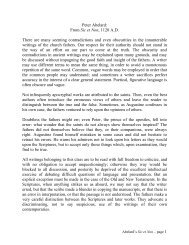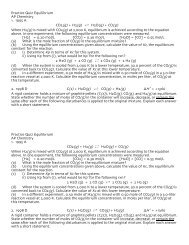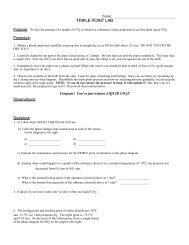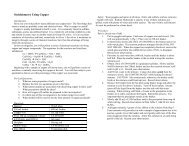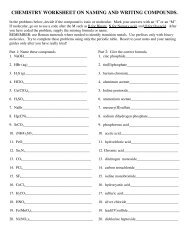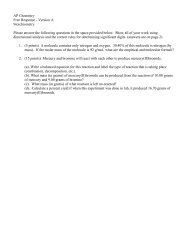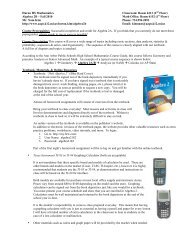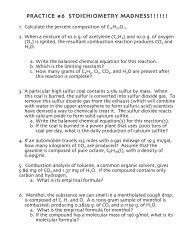Law of Multiple and Definite Proportions
Law of Multiple and Definite Proportions
Law of Multiple and Definite Proportions
Create successful ePaper yourself
Turn your PDF publications into a flip-book with our unique Google optimized e-Paper software.
THE LAW OF DEFINITE AND MULTIPLE PROPORTIONS<br />
AP chemistry lab<br />
The <strong>Law</strong> <strong>of</strong> <strong>Definite</strong> <strong>Proportions</strong> was first proposed by Joseph Proust in 1799. It states that a<br />
pure compound always consists <strong>of</strong> the same elements combined in the same proportion by mass. In<br />
this experiment, you are going to confirm this law by preparing a manganese-chlorine compound.<br />
You will dissolve manganese metal in hydrochloric acid. From the mass <strong>of</strong> each element reacted, you<br />
can calculate the ratio <strong>of</strong> atoms which have combined. From the ratio <strong>of</strong> the atoms combined, you<br />
can calculate the "empirical" or simplest formula.<br />
There are two ways to represent the formula for a compound. The first type <strong>of</strong> formula is<br />
called the empirical formula, which is simplest formula possible for the compound. It consists <strong>of</strong><br />
the whole number ratio <strong>of</strong> the atoms, which have combined chemically. The second type <strong>of</strong> formula<br />
<strong>of</strong> a compound is called the molecular formula. It represents the actual ratio <strong>of</strong> the different kinds<br />
<strong>of</strong> atoms present in the compound. For example, the empirical formula <strong>of</strong> benzene, is C1H1, <strong>and</strong> its<br />
molecular formula is C6H6. In order to determine the molecular formula for a compound, you must<br />
know both its empirical formula <strong>and</strong> its molecular weight. For example, benzene has a mass <strong>of</strong> 13.02<br />
g/mole according to its empirical formula <strong>of</strong> CH (one atom <strong>of</strong> carbon @ 12.01 g/mole <strong>and</strong> one atom<br />
<strong>of</strong> hydrogen @ 1.01 gram/mole) <strong>and</strong> a molecular weight <strong>of</strong> 78.12 grams/mole (6 atoms <strong>of</strong> carbon, plus<br />
6 atoms <strong>of</strong> hydrogen). The ratio <strong>of</strong> the molecular weight to the empirical formula weight is<br />
6:1 (78.12/13.02 = 6) Therefore, the actual ratio <strong>of</strong> the atoms or molecular formula <strong>of</strong><br />
benzene is six times CH or C6H6.<br />
PRE LAB QUESTIONS:<br />
In a laboratory setting Cu (s) was reacted with I2 (s). Calculate the empirical formula <strong>of</strong> an iodide <strong>of</strong><br />
copper that contains .098 grams <strong>of</strong> copper <strong>and</strong> 0.190 grams <strong>of</strong> iodine. Be sure to include the proper<br />
significant figures.<br />
MATERIALS:<br />
Manganese metal, Mn(s)<br />
hydrochloric acid, 10.00 M HCl<br />
scoopula<br />
test tube clamp<br />
clean s<strong>and</strong><br />
Beral pipet<br />
18 X 150 mm test tube<br />
hotplate<br />
2-12 oz Al cans with tops removed<br />
beaker tongs<br />
SAFETY:<br />
Caution: Manganese metal powder is toxic. Please be very careful when measuring the<br />
mass <strong>of</strong> the powder. If you spill any powder, wipe it up with a wet soapy sponge. Rinse<br />
the powder <strong>of</strong>f the sponge before putting the sponge back in the soapy water.<br />
Caution: 10 M HCl is very dangerous <strong>and</strong> corrosive. If you spill any acid, neutralize with<br />
baking soda <strong>and</strong> clean up with a soapy sponge. When reacting <strong>and</strong> heating the Mn metal,<br />
do not breathe the vapor or evaporating liquid. It will contain acid fumes.<br />
Caution: Do not touch the aluminum can, as it will become quite hot during the experiment.<br />
Always approach the hot can by lowering your h<strong>and</strong> from above. When you do need to<br />
remove the can, always use beaker tongs. When touching the hot test tube, use a test tube<br />
clamp.<br />
PROCEDURE:<br />
1.<br />
Turn a hot plate to its highest setting. Add roughly 200 grams <strong>of</strong> dry, clean s<strong>and</strong> to a<br />
12-ounce aluminum soda can with its top removed <strong>and</strong> place it in the middle <strong>of</strong> the hot plate.<br />
2.<br />
Find the mass <strong>of</strong> a large (25 x 150 mm) clean, dry test tube. Add manganese metal powder to the test<br />
tube until its mass increases by 0.150 to 0.200 grams. Record these mass measurements.<br />
3.<br />
Carefully add 5 drops <strong>of</strong> 10.00 molar hydrochloric acid to the manganese metal. When the<br />
reaction subsides, add another 5 drops <strong>of</strong> hydrochloric acid. Continue to add the hydrochloric<br />
acid in five-drop increments until the reaction no longer effervesces or you have added a total
<strong>of</strong> 25 drops <strong>of</strong> acid. Observe the temperature <strong>of</strong> the test tube.<br />
4.<br />
Push the test tube to the bottom <strong>of</strong> the hot s<strong>and</strong> <strong>and</strong> tilt it at an angle so that it touches the side<br />
<strong>of</strong> the aluminum can. Rotate the test tube every few minutes keeping the test tube touching<br />
the side <strong>of</strong> the aluminum can. This inhibits moisture from condensing on the top <strong>of</strong> the test<br />
tube.<br />
5.<br />
Listen to the test tube. It will sizzle or crackle as the water leaves the hydrate. Wait a few minutes<br />
after it no longer makes noise to be certain all the water has been driven from the salt. Using a test<br />
tube clamp, remove it from the s<strong>and</strong> <strong>and</strong> place it into a second clean, dry aluminum can. The second<br />
can will act as a heat sink, conducting the heat away from the test tube quickly.<br />
6.<br />
Once the aluminum can heat sink has cooled, remove the test tube <strong>and</strong> place in cold water until the<br />
bottom no longer feels warm. Wipe the test tube dry with paper towel. Measure the mass <strong>of</strong> the test<br />
tube containing the dried salt to the precision <strong>of</strong> your balance.<br />
7.<br />
Repeat the heating <strong>and</strong> cooling process until the mass <strong>of</strong> the test tube <strong>and</strong> its contents is constant.<br />
That is, the mass has not changed by more than 0.010 grams between measurements.<br />
8.<br />
When you are finished with lab, be sure to rinse the product out <strong>of</strong> the test tube <strong>and</strong> clean it with a<br />
test tube brush. Wash down your lab station <strong>and</strong> be sure to wash your h<strong>and</strong>s before leaving lab.<br />
DATA:<br />
What did you measure?<br />
What measurements will be necessary to determine the empirical ratio <strong>of</strong> Manganese to Chlorine?<br />
This is what should appear in your data table!<br />
CALCULATIONS:<br />
A) Calculate the mass <strong>of</strong> manganese metal.<br />
B) Calculate the mass <strong>of</strong> the manganese chloride.<br />
C) Calculate the mass <strong>of</strong> chlorine, which has combined with Mn.<br />
D) Calculate the number <strong>of</strong> moles <strong>of</strong> manganese metal, which has reacted.<br />
E) Calculate the number <strong>of</strong> moles <strong>of</strong> chlorine, which has reacted.<br />
F) Calculate the ratio <strong>of</strong> the number <strong>of</strong> moles <strong>of</strong> Manganese to Chlorine. In this calculation, make<br />
Mn the denominator. In other words, express chlorine as a multiple <strong>of</strong> the Mn. Be sure to let the<br />
limitations <strong>of</strong> the equipment decide how many decimal places are in your ratio.<br />
CONCLUSION:<br />
State yours.<br />
ERROR ANALYSIS:<br />
• The accepted value for the formula <strong>of</strong> Mn to Cl is (1:2).<br />
• How does your formula compare?<br />
• Is it chlorine heavy or chlorine light?<br />
• What is your percent error based on your ratio <strong>of</strong> chlorine?<br />
• Is it minorly flawed or significantly flawed?<br />
• Create a logical argument, which is supported by something you observed. This procedural<br />
item could be a procedural error or a limitation <strong>of</strong> the procedure. How does this procedural<br />
error/limitation account for your ratio being something other that the accepted one? Can<br />
you quantify how much your stated errors actually manifested themselves in your final<br />
result? Dig deep on this one. It is tough to do!<br />
DISCSSION OF THEORY:<br />
Include three items that you will want to remember for the AP exam. Make sure they are specific to<br />
this experiment.<br />
POST LAB QUESTIONS:<br />
1.<br />
According to your observations, what evidence is there that a chemical reaction has taken place?
2.<br />
Do a little research <strong>and</strong> determine how many forms <strong>of</strong> manganese chloride are known to exist. Is<br />
your result one that is based on reality? Explain. Oh yes, be sure to cite the source(s) for your<br />
information.<br />
3.<br />
According to your results, what is the word equation <strong>and</strong> balanced, chemical equation for the<br />
reaction-taking place in this lab?<br />
4.<br />
According to your results, how does the mass <strong>of</strong> product (manganese chloride) compare with the<br />
mass <strong>of</strong> manganese metal reacted? How do you explain the difference?<br />
5.<br />
If your test tube was not properly dry after step 6 <strong>of</strong> the procedure, how would this affect the ratio<br />
<strong>of</strong> your final empirical formula? Be sure to explain in great detail.<br />
6.<br />
Which expression best describes this chemical reaction;<br />
endothermic <strong>and</strong> spontaneous,<br />
endothermic <strong>and</strong> non spontaneous,<br />
exothermic <strong>and</strong> spontaneous,<br />
exothermic <strong>and</strong> non spontaneous?<br />
Be sure to base your response on specific things you observed.<br />
7.<br />
Antimony forms two chlorides with very different properties. One chloride is a solid <strong>and</strong> melts at 73<br />
°C <strong>and</strong> 46.8% chlorine by mass. The other is a liquid that boils at 140 °C <strong>and</strong> contains 59.3% chlorine<br />
by mass.<br />
a. Determine the empirical formula for each.<br />
b. Show how these results illustrate the law <strong>of</strong> multiple proportions.<br />
8.<br />
When massing your powdered manganese, you dropped a little bit outside <strong>of</strong> the test tube, but it<br />
still l<strong>and</strong>ed on the balance pan. How would this affect the mathematical ratio <strong>of</strong> your final empirical<br />
formula? Be sure to explain in great detail. How would this error actually affect the ratio <strong>of</strong> the<br />
final product? Details please.



